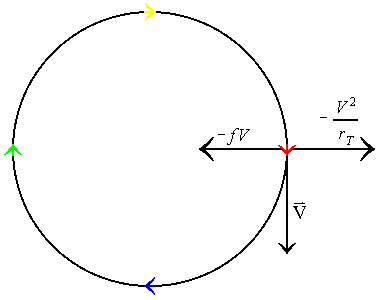

Inertial flow is not one of the more commonly seen flows in the atmosphere, yet it does exist. The inertial wind is derived from the balance of the following forces in the n equation of motion:
The centrifugal force: 
 The coriolis force:
The coriolis force: 
Inertial flows are also known as inertial oscillations, since air parcels under the influence of inertial balance follow circular paths in an anti-cyclonic manner. The following graphic shows the illustration of the forces involved in inertial flow:

After examining the graphic and applying the inertial flow equation, it becomes apparent that these oscillations are very regular and rotate with a certain period. The period of these oscillations is:

where:

 is the latitude and P is the period of the oscillation
is the latitude and P is the period of the oscillation
As stated above, inertial flow is not one of the more commonly seen forces in the atmosphere. The reason is that the pressure gradient force drives most flows in the atmosphere. Since the pressure gradient force is assumed to be zero in inertial flow, this line of reasoning is justified. The only situations where inertial flow may be observed are in the center of large anti-cyclones or cyclones, where pressure gradients are very weak.
Although atmospheric conditions may not be favorable at most times for inertial flow, it is more prevalent in oceanic currents, where transient winds blowing across the surface are more likely to drive the current, as opposed to internal pressure gradients.
 Next topic: References
Next topic: References
 Previous topic: Gradient flow
Previous topic: Gradient flow